weight BMW M6 GRAN COUPE 2015 F06M Owner's Manual
[x] Cancel search | Manufacturer: BMW, Model Year: 2015, Model line: M6 GRAN COUPE, Model: BMW M6 GRAN COUPE 2015 F06MPages: 226, PDF Size: 4.76 MB
Page 64 of 226
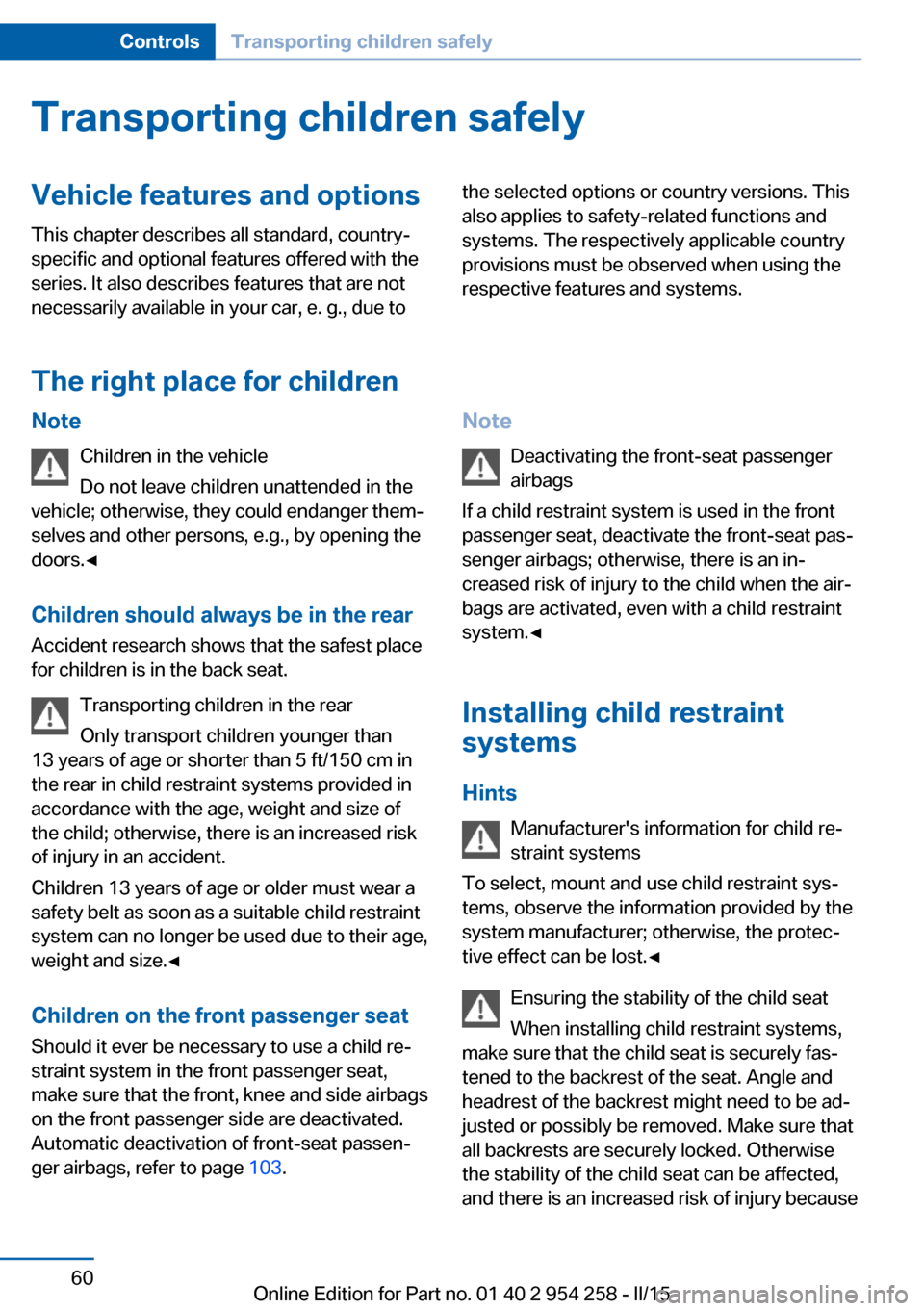
Transporting children safelyVehicle features and optionsThis chapter describes all standard, country-
specific and optional features offered with the
series. It also describes features that are not
necessarily available in your car, e. g., due tothe selected options or country versions. This
also applies to safety-related functions and
systems. The respectively applicable country
provisions must be observed when using the
respective features and systems.
The right place for children
Note
Children in the vehicle
Do not leave children unattended in the
vehicle; otherwise, they could endanger them‐
selves and other persons, e.g., by opening the
doors.◀
Children should always be in the rear Accident research shows that the safest place
for children is in the back seat.
Transporting children in the rear
Only transport children younger than
13 years of age or shorter than 5 ft/150 cm in
the rear in child restraint systems provided in
accordance with the age, weight and size of
the child; otherwise, there is an increased risk
of injury in an accident.
Children 13 years of age or older must wear a
safety belt as soon as a suitable child restraint
system can no longer be used due to their age,
weight and size.◀
Children on the front passenger seat
Should it ever be necessary to use a child re‐
straint system in the front passenger seat,
make sure that the front, knee and side airbags
on the front passenger side are deactivated.
Automatic deactivation of front-seat passen‐
ger airbags, refer to page 103.Note
Deactivating the front-seat passenger
airbags
If a child restraint system is used in the front
passenger seat, deactivate the front-seat pas‐
senger airbags; otherwise, there is an in‐
creased risk of injury to the child when the air‐
bags are activated, even with a child restraint
system.◀
Installing child restraint
systems
Hints Manufacturer's information for child re‐straint systems
To select, mount and use child restraint sys‐
tems, observe the information provided by the
system manufacturer; otherwise, the protec‐
tive effect can be lost.◀
Ensuring the stability of the child seat
When installing child restraint systems,
make sure that the child seat is securely fas‐
tened to the backrest of the seat. Angle and
headrest of the backrest might need to be ad‐
justed or possibly be removed. Make sure that
all backrests are securely locked. Otherwise
the stability of the child seat can be affected,
and there is an increased risk of injury becauseSeite 60ControlsTransporting children safely60
Online Edition for Part no. 01 40 2 954 258 - II/15
Page 66 of 226
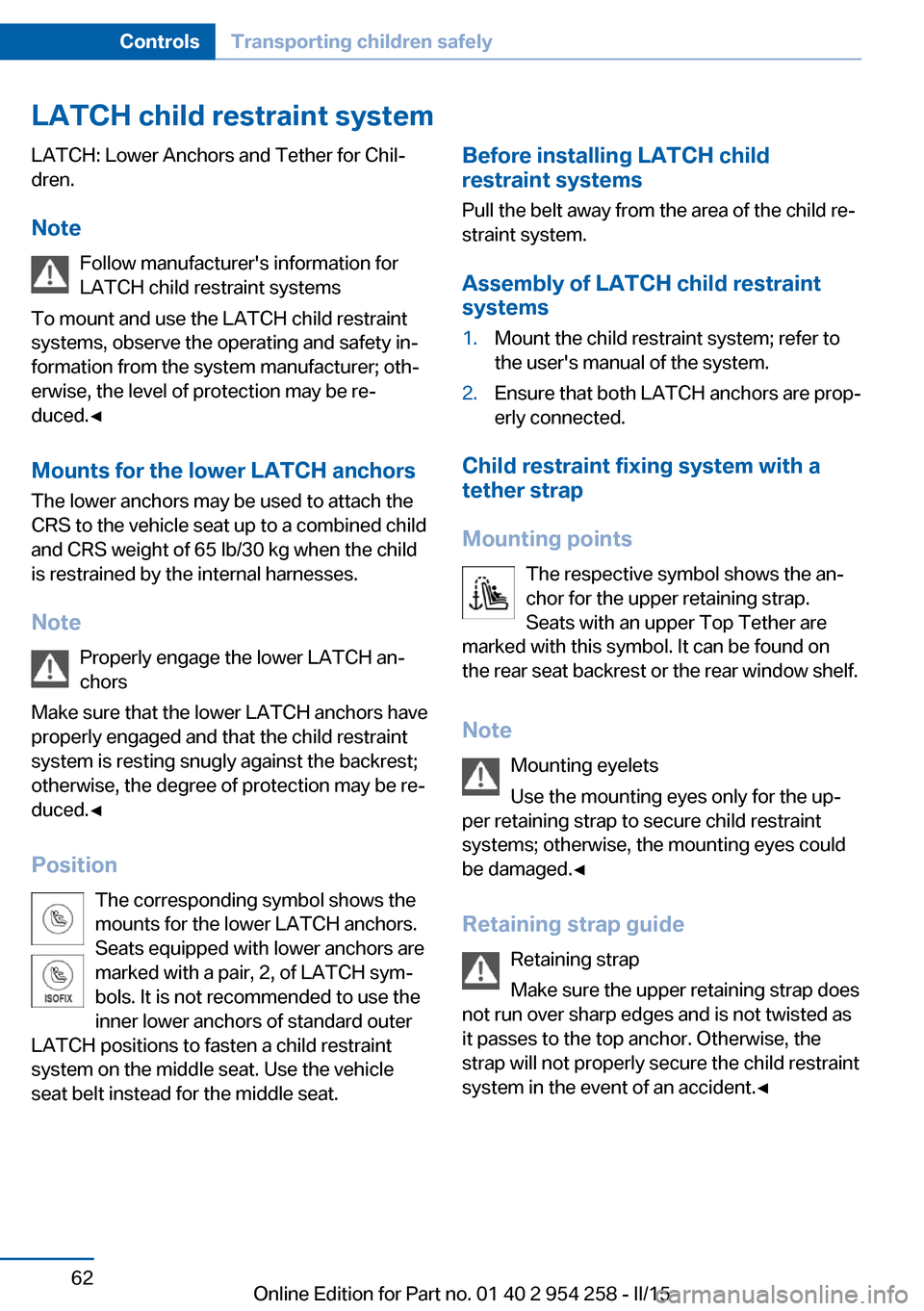
LATCH child restraint systemLATCH: Lower Anchors and Tether for Chil‐
dren.
Note Follow manufacturer's information for
LATCH child restraint systems
To mount and use the LATCH child restraint
systems, observe the operating and safety in‐
formation from the system manufacturer; oth‐
erwise, the level of protection may be re‐
duced.◀
Mounts for the lower LATCH anchors
The lower anchors may be used to attach the
CRS to the vehicle seat up to a combined child
and CRS weight of 65 lb/30 kg when the child
is restrained by the internal harnesses.
Note Properly engage the lower LATCH an‐
chors
Make sure that the lower LATCH anchors have
properly engaged and that the child restraint
system is resting snugly against the backrest;
otherwise, the degree of protection may be re‐
duced.◀
Position The corresponding symbol shows the
mounts for the lower LATCH anchors.
Seats equipped with lower anchors are
marked with a pair, 2, of LATCH sym‐
bols. It is not recommended to use the
inner lower anchors of standard outer
LATCH positions to fasten a child restraint
system on the middle seat. Use the vehicle
seat belt instead for the middle seat.Before installing LATCH child
restraint systems
Pull the belt away from the area of the child re‐
straint system.
Assembly of LATCH child restraint
systems1.Mount the child restraint system; refer to
the user's manual of the system.2.Ensure that both LATCH anchors are prop‐
erly connected.
Child restraint fixing system with a
tether strap
Mounting points The respective symbol shows the an‐
chor for the upper retaining strap.
Seats with an upper Top Tether are
marked with this symbol. It can be found on
the rear seat backrest or the rear window shelf.
Note Mounting eyelets
Use the mounting eyes only for the up‐
per retaining strap to secure child restraint
systems; otherwise, the mounting eyes could
be damaged.◀
Retaining strap guide Retaining strap
Make sure the upper retaining strap does
not run over sharp edges and is not twisted as
it passes to the top anchor. Otherwise, the
strap will not properly secure the child restraint
system in the event of an accident.◀
Seite 62ControlsTransporting children safely62
Online Edition for Part no. 01 40 2 954 258 - II/15
Page 170 of 226

LoadingVehicle features and options
This chapter describes all standard, country-
specific and optional features offered with the
series. It also describes features that are not
necessarily available in your car, e. g., due to
the selected options or country versions. This
also applies to safety-related functions and
systems. The respectively applicable country
provisions must be observed when using the
respective features and systems.
Hints Overloading the vehicle
To avoid exceeding the approved ca‐
pacity of the tires, never overload the vehicle.
Overloading can lead to overheating and in‐
creases the rate at which damage develops in‐
side the tires. This could result in a sudden
loss of tire inflation pressure.◀
No fluids in the cargo area
Make sure that fluids do not leak into the
cargo area; otherwise, the vehicle may be dam‐
aged.◀
Heavy and hard objects
Do not stow any heavy and hard objects
in the car's interior without securing them; oth‐
erwise, they may present a danger to occu‐
pants, e.g., during braking and evasive maneu‐
vers.◀
Determining the load limit1.Locate the following statement on your ve‐
hicle’s placard:▷The combined weight of occupants
and cargo should never exceed XXX kg
or YYY lbs. Otherwise, damage to thevehicle and unstable driving situations
may result.2.Determine the combined weight of the
driver and passengers that will be riding in
your vehicle.3.Subtract the combined weight of the driver
and passengers from XXX kilograms or
YYY pounds.4.The resulting figure equals the available
amount of cargo and luggage load ca‐
pacity.
For example, if the YYY amount equals
1,000 lbs and there will be four 150 lbs
passengers in your vehicle, the amount of
available cargo and luggage load capacity
is 400 lbs: 1,000 lbs minus 600 lbs =
400 lbs.5.Determine the combined weight of lug‐
gage and cargo being loaded on the vehi‐
cle. That weight may not safely exceed the
available cargo and luggage load capacity
calculated in Step 4.Seite 166Driving tipsLoading166
Online Edition for Part no. 01 40 2 954 258 - II/15
Page 171 of 226
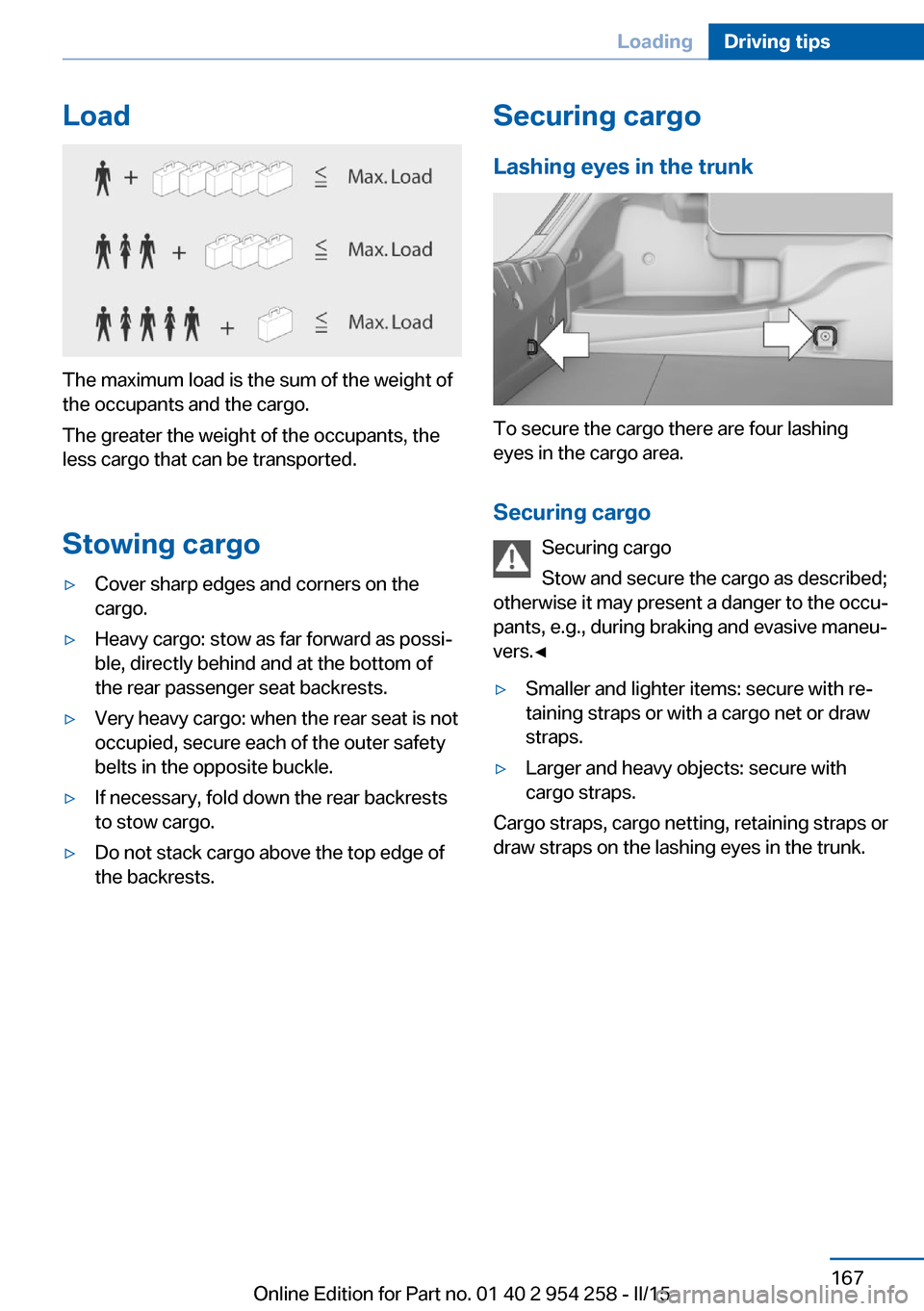
Load
The maximum load is the sum of the weight of
the occupants and the cargo.
The greater the weight of the occupants, the
less cargo that can be transported.
Stowing cargo
▷Cover sharp edges and corners on the
cargo.▷Heavy cargo: stow as far forward as possi‐
ble, directly behind and at the bottom of
the rear passenger seat backrests.▷Very heavy cargo: when the rear seat is not
occupied, secure each of the outer safety
belts in the opposite buckle.▷If necessary, fold down the rear backrests
to stow cargo.▷Do not stack cargo above the top edge of
the backrests.Securing cargo
Lashing eyes in the trunk
To secure the cargo there are four lashing
eyes in the cargo area.
Securing cargo Securing cargo
Stow and secure the cargo as described;
otherwise it may present a danger to the occu‐
pants, e.g., during braking and evasive maneu‐
vers.◀
▷Smaller and lighter items: secure with re‐
taining straps or with a cargo net or draw
straps.▷Larger and heavy objects: secure with
cargo straps.
Cargo straps, cargo netting, retaining straps or
draw straps on the lashing eyes in the trunk.
Seite 167LoadingDriving tips167
Online Edition for Part no. 01 40 2 954 258 - II/15
Page 172 of 226
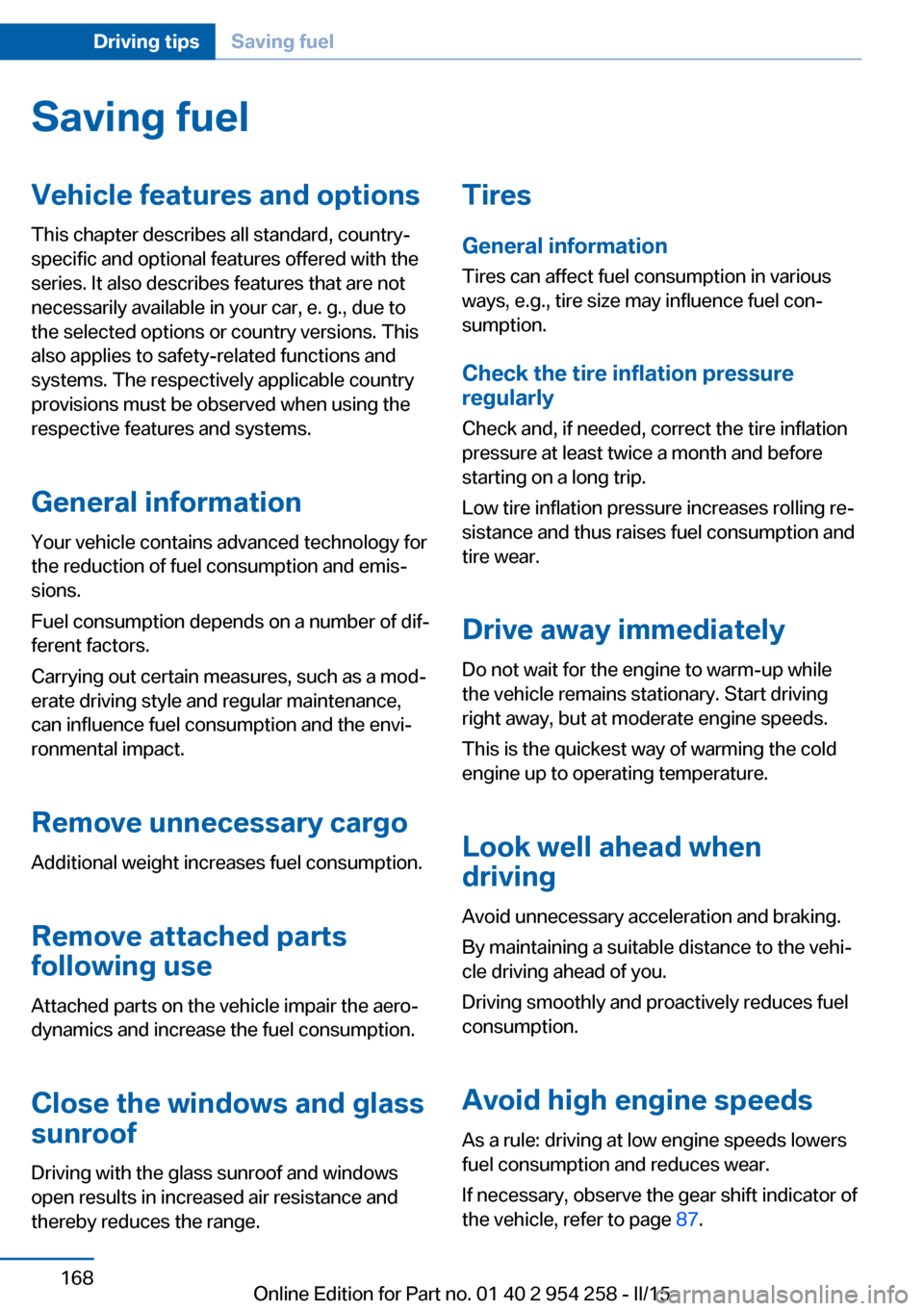
Saving fuelVehicle features and optionsThis chapter describes all standard, country-
specific and optional features offered with the
series. It also describes features that are not
necessarily available in your car, e. g., due to
the selected options or country versions. This
also applies to safety-related functions and
systems. The respectively applicable country
provisions must be observed when using the
respective features and systems.
General information Your vehicle contains advanced technology for
the reduction of fuel consumption and emis‐
sions.
Fuel consumption depends on a number of dif‐
ferent factors.
Carrying out certain measures, such as a mod‐
erate driving style and regular maintenance,
can influence fuel consumption and the envi‐
ronmental impact.
Remove unnecessary cargo
Additional weight increases fuel consumption.
Remove attached parts
following use
Attached parts on the vehicle impair the aero‐
dynamics and increase the fuel consumption.
Close the windows and glass
sunroof
Driving with the glass sunroof and windows
open results in increased air resistance and
thereby reduces the range.Tires
General information
Tires can affect fuel consumption in various
ways, e.g., tire size may influence fuel con‐
sumption.
Check the tire inflation pressure
regularly
Check and, if needed, correct the tire inflation
pressure at least twice a month and before
starting on a long trip.
Low tire inflation pressure increases rolling re‐
sistance and thus raises fuel consumption and
tire wear.
Drive away immediately
Do not wait for the engine to warm-up while
the vehicle remains stationary. Start driving
right away, but at moderate engine speeds.
This is the quickest way of warming the cold
engine up to operating temperature.
Look well ahead when
driving
Avoid unnecessary acceleration and braking.
By maintaining a suitable distance to the vehi‐
cle driving ahead of you.
Driving smoothly and proactively reduces fuel
consumption.
Avoid high engine speeds
As a rule: driving at low engine speeds lowers
fuel consumption and reduces wear.
If necessary, observe the gear shift indicator of
the vehicle, refer to page 87.Seite 168Driving tipsSaving fuel168
Online Edition for Part no. 01 40 2 954 258 - II/15
Page 214 of 226
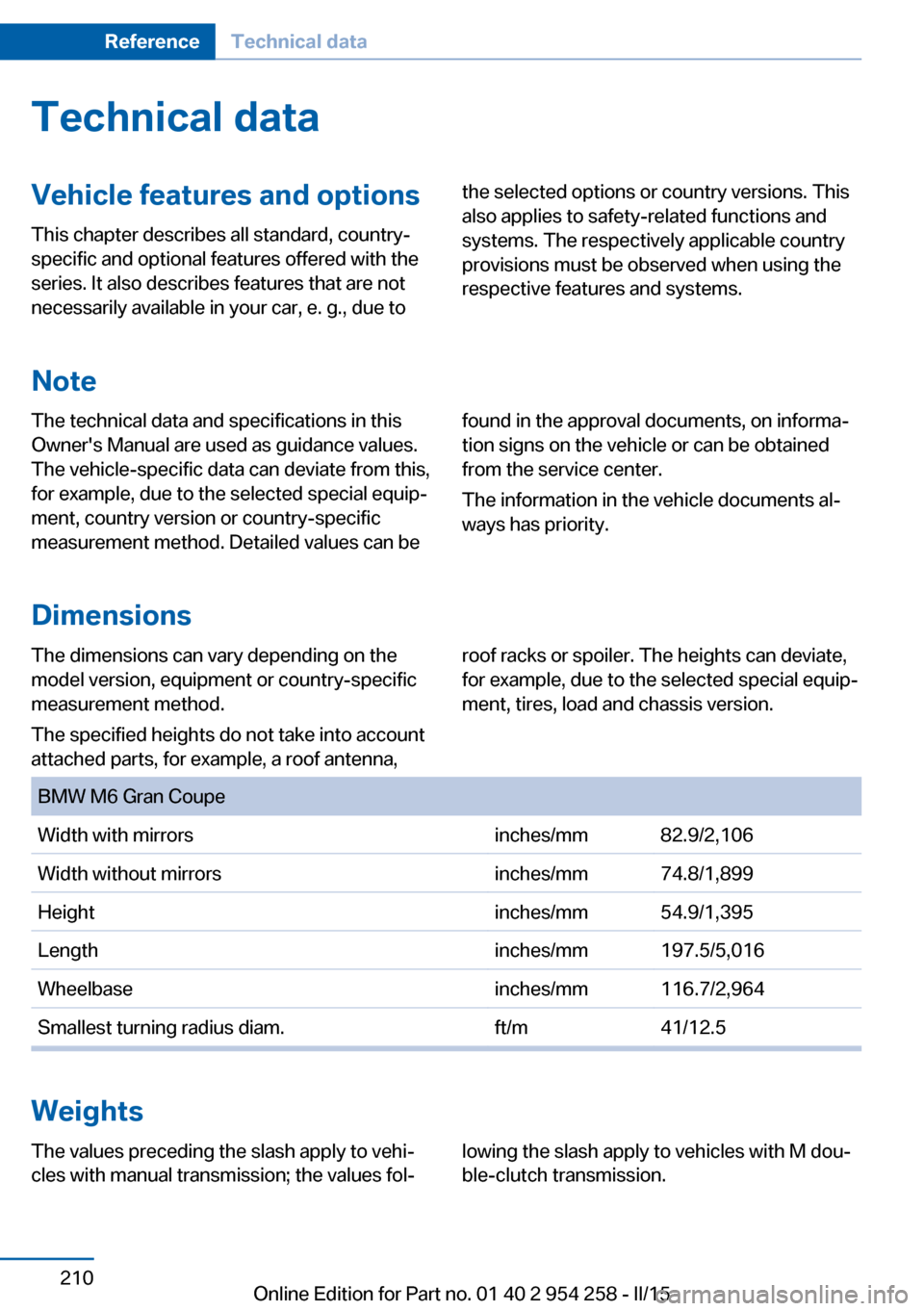
Technical dataVehicle features and options
This chapter describes all standard, country-
specific and optional features offered with the
series. It also describes features that are not
necessarily available in your car, e. g., due tothe selected options or country versions. This
also applies to safety-related functions and
systems. The respectively applicable country
provisions must be observed when using the
respective features and systems.
Note
The technical data and specifications in this
Owner's Manual are used as guidance values.
The vehicle-specific data can deviate from this,
for example, due to the selected special equip‐
ment, country version or country-specific
measurement method. Detailed values can befound in the approval documents, on informa‐
tion signs on the vehicle or can be obtained
from the service center.
The information in the vehicle documents al‐
ways has priority.
Dimensions
The dimensions can vary depending on the
model version, equipment or country-specific
measurement method.
The specified heights do not take into account
attached parts, for example, a roof antenna,roof racks or spoiler. The heights can deviate,
for example, due to the selected special equip‐
ment, tires, load and chassis version. BMW M6 Gran CoupeWidth with mirrorsinches/mm82.9/2,106Width without mirrorsinches/mm74.8/1,899Heightinches/mm54.9/1,395Lengthinches/mm197.5/5,016Wheelbaseinches/mm116.7/2,964Smallest turning radius diam.ft/m41/12.5
Weights
The values preceding the slash apply to vehi‐
cles with manual transmission; the values fol‐lowing the slash apply to vehicles with M dou‐
ble-clutch transmission.Seite 210ReferenceTechnical data210
Online Edition for Part no. 01 40 2 954 258 - II/15
Page 215 of 226
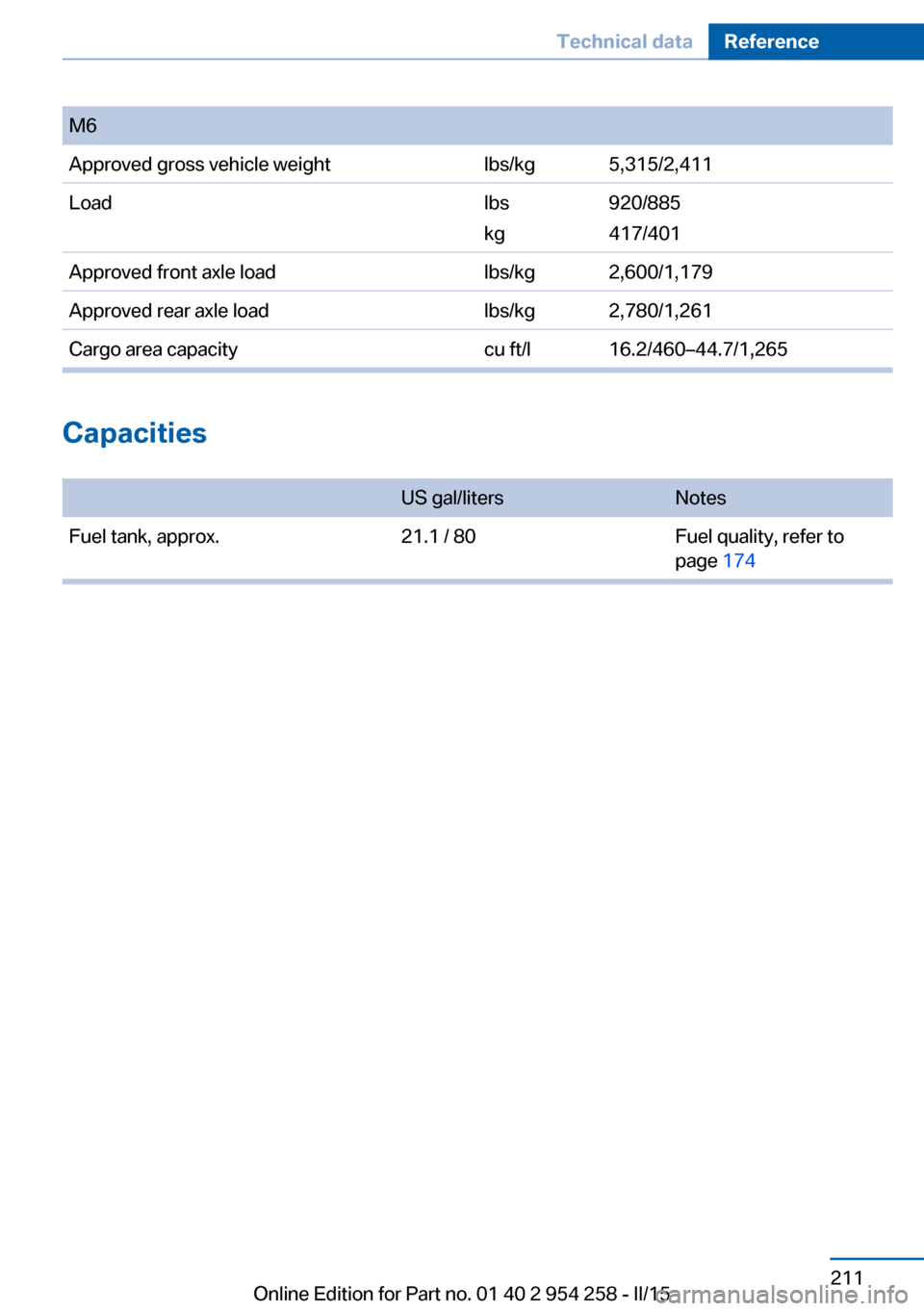
M6Approved gross vehicle weightlbs/kg5,315/2,411Loadlbs
kg920/885
417/401Approved front axle loadlbs/kg2,600/1,179Approved rear axle loadlbs/kg2,780/1,261Cargo area capacitycu ft/l16.2/460–44.7/1,265
Capacities
US gal/litersNotesFuel tank, approx.21.1 / 80Fuel quality, refer to
page 174Seite 211Technical dataReference211
Online Edition for Part no. 01 40 2 954 258 - II/15
Page 216 of 226
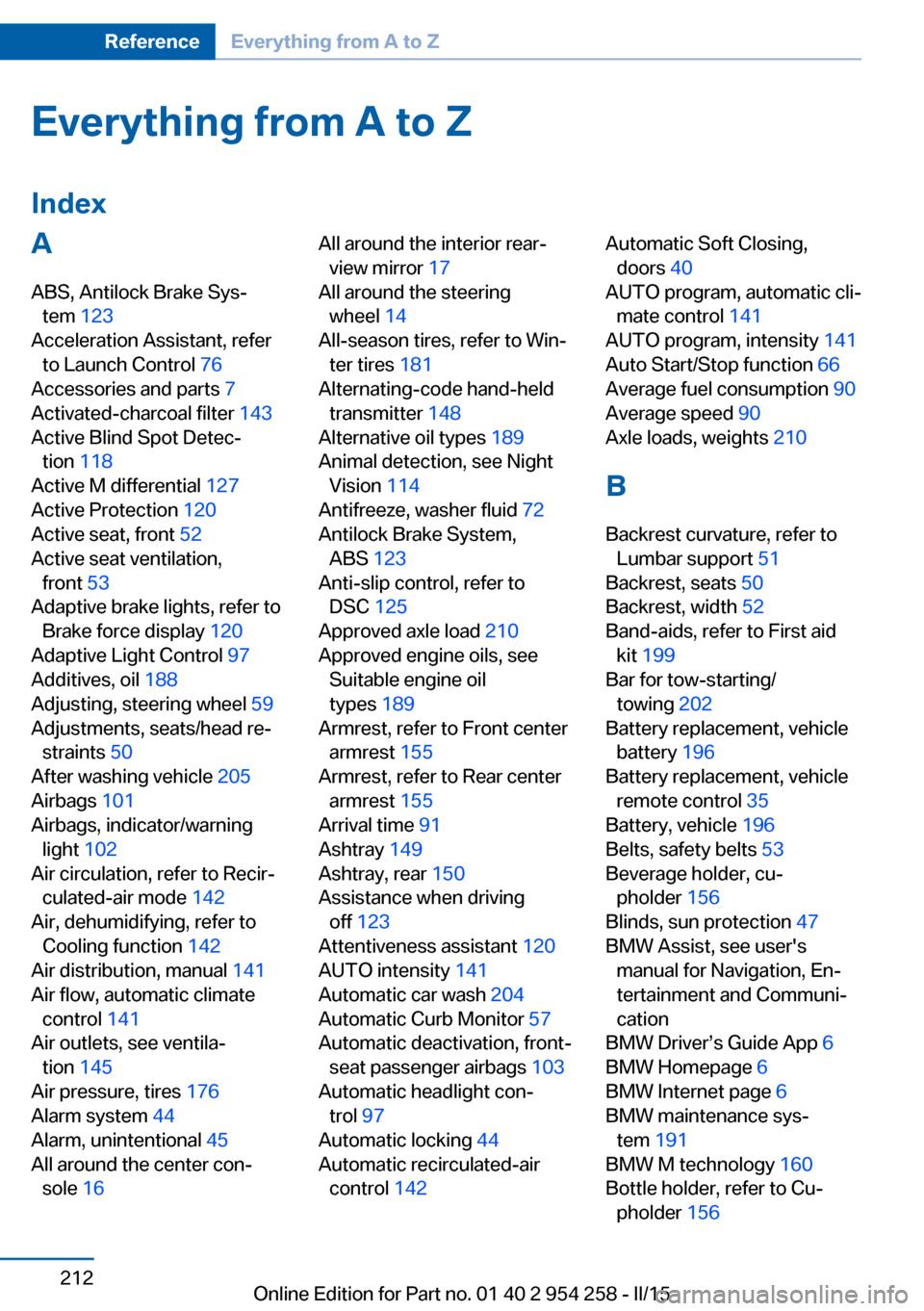
Everything from A to Z
IndexA ABS, Antilock Brake Sys‐ tem 123
Acceleration Assistant, refer to Launch Control 76
Accessories and parts 7
Activated-charcoal filter 143
Active Blind Spot Detec‐ tion 118
Active M differential 127
Active Protection 120
Active seat, front 52
Active seat ventilation, front 53
Adaptive brake lights, refer to Brake force display 120
Adaptive Light Control 97
Additives, oil 188
Adjusting, steering wheel 59
Adjustments, seats/head re‐ straints 50
After washing vehicle 205
Airbags 101
Airbags, indicator/warning light 102
Air circulation, refer to Recir‐ culated-air mode 142
Air, dehumidifying, refer to Cooling function 142
Air distribution, manual 141
Air flow, automatic climate control 141
Air outlets, see ventila‐ tion 145
Air pressure, tires 176
Alarm system 44
Alarm, unintentional 45
All around the center con‐ sole 16 All around the interior rear‐
view mirror 17
All around the steering wheel 14
All-season tires, refer to Win‐ ter tires 181
Alternating-code hand-held transmitter 148
Alternative oil types 189
Animal detection, see Night Vision 114
Antifreeze, washer fluid 72
Antilock Brake System, ABS 123
Anti-slip control, refer to DSC 125
Approved axle load 210
Approved engine oils, see Suitable engine oil
types 189
Armrest, refer to Front center armrest 155
Armrest, refer to Rear center armrest 155
Arrival time 91
Ashtray 149
Ashtray, rear 150
Assistance when driving off 123
Attentiveness assistant 120
AUTO intensity 141
Automatic car wash 204
Automatic Curb Monitor 57
Automatic deactivation, front- seat passenger airbags 103
Automatic headlight con‐ trol 97
Automatic locking 44
Automatic recirculated-air control 142 Automatic Soft Closing,
doors 40
AUTO program, automatic cli‐ mate control 141
AUTO program, intensity 141
Auto Start/Stop function 66
Average fuel consumption 90
Average speed 90
Axle loads, weights 210
B Backrest curvature, refer to Lumbar support 51
Backrest, seats 50
Backrest, width 52
Band-aids, refer to First aid kit 199
Bar for tow-starting/ towing 202
Battery replacement, vehicle battery 196
Battery replacement, vehicle remote control 35
Battery, vehicle 196
Belts, safety belts 53
Beverage holder, cu‐ pholder 156
Blinds, sun protection 47
BMW Assist, see user's manual for Navigation, En‐
tertainment and Communi‐
cation
BMW Driver’s Guide App 6
BMW Homepage 6
BMW Internet page 6
BMW maintenance sys‐ tem 191
BMW M technology 160
Bottle holder, refer to Cu‐ pholder 156 Seite 212ReferenceEverything from A to Z212
Online Edition for Part no. 01 40 2 954 258 - II/15
Page 219 of 226
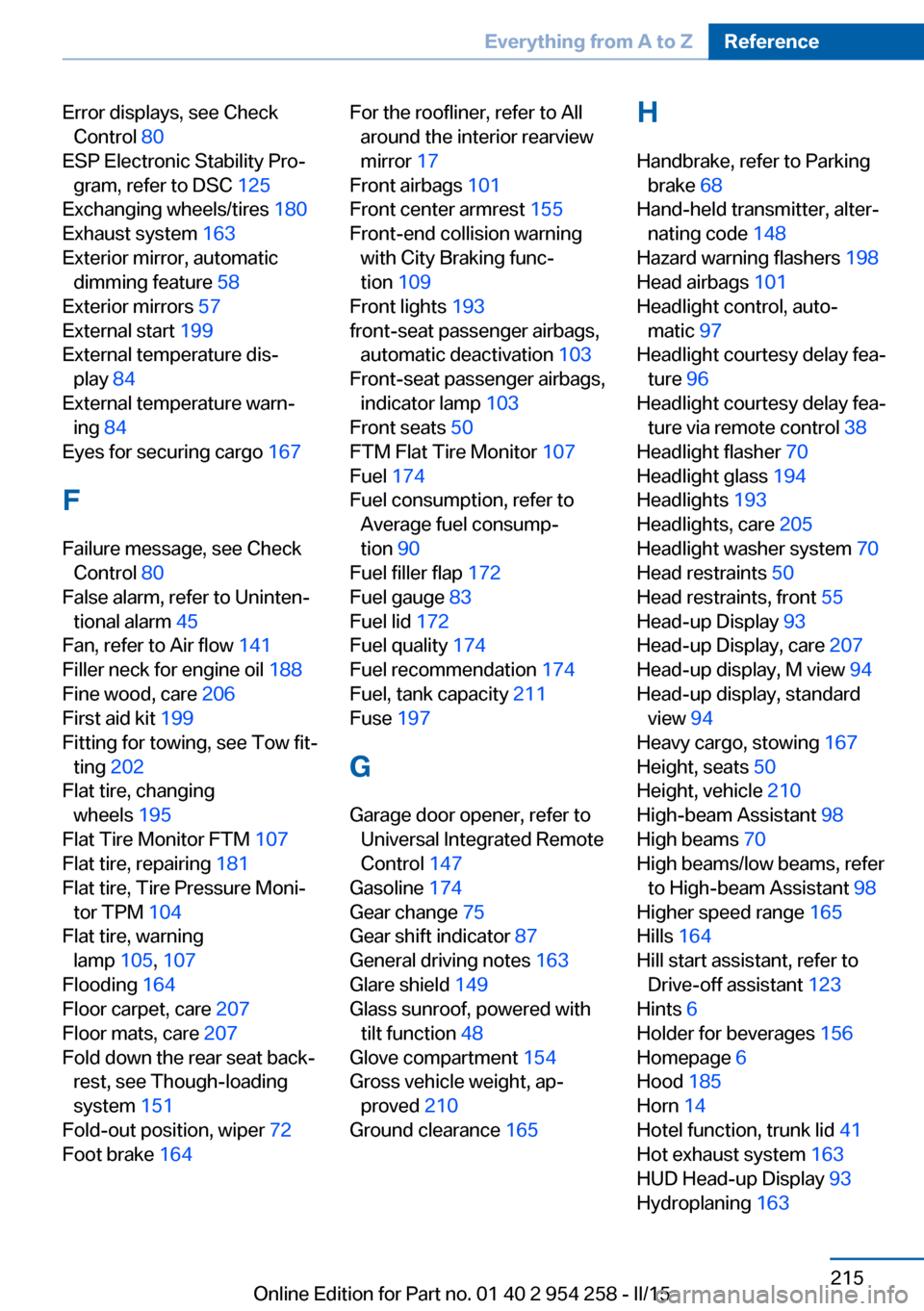
Error displays, see CheckControl 80
ESP Electronic Stability Pro‐ gram, refer to DSC 125
Exchanging wheels/tires 180
Exhaust system 163
Exterior mirror, automatic dimming feature 58
Exterior mirrors 57
External start 199
External temperature dis‐ play 84
External temperature warn‐ ing 84
Eyes for securing cargo 167
F
Failure message, see Check Control 80
False alarm, refer to Uninten‐ tional alarm 45
Fan, refer to Air flow 141
Filler neck for engine oil 188
Fine wood, care 206
First aid kit 199
Fitting for towing, see Tow fit‐ ting 202
Flat tire, changing wheels 195
Flat Tire Monitor FTM 107
Flat tire, repairing 181
Flat tire, Tire Pressure Moni‐ tor TPM 104
Flat tire, warning lamp 105, 107
Flooding 164
Floor carpet, care 207
Floor mats, care 207
Fold down the rear seat back‐ rest, see Though-loading
system 151
Fold-out position, wiper 72
Foot brake 164 For the roofliner, refer to All
around the interior rearview
mirror 17
Front airbags 101
Front center armrest 155
Front-end collision warning with City Braking func‐
tion 109
Front lights 193
front-seat passenger airbags, automatic deactivation 103
Front-seat passenger airbags, indicator lamp 103
Front seats 50
FTM Flat Tire Monitor 107
Fuel 174
Fuel consumption, refer to Average fuel consump‐
tion 90
Fuel filler flap 172
Fuel gauge 83
Fuel lid 172
Fuel quality 174
Fuel recommendation 174
Fuel, tank capacity 211
Fuse 197
G
Garage door opener, refer to Universal Integrated Remote
Control 147
Gasoline 174
Gear change 75
Gear shift indicator 87
General driving notes 163
Glare shield 149
Glass sunroof, powered with tilt function 48
Glove compartment 154
Gross vehicle weight, ap‐ proved 210
Ground clearance 165 H
Handbrake, refer to Parking brake 68
Hand-held transmitter, alter‐ nating code 148
Hazard warning flashers 198
Head airbags 101
Headlight control, auto‐ matic 97
Headlight courtesy delay fea‐ ture 96
Headlight courtesy delay fea‐ ture via remote control 38
Headlight flasher 70
Headlight glass 194
Headlights 193
Headlights, care 205
Headlight washer system 70
Head restraints 50
Head restraints, front 55
Head-up Display 93
Head-up Display, care 207
Head-up display, M view 94
Head-up display, standard view 94
Heavy cargo, stowing 167
Height, seats 50
Height, vehicle 210
High-beam Assistant 98
High beams 70
High beams/low beams, refer to High-beam Assistant 98
Higher speed range 165
Hills 164
Hill start assistant, refer to Drive-off assistant 123
Hints 6
Holder for beverages 156
Homepage 6
Hood 185
Horn 14
Hotel function, trunk lid 41
Hot exhaust system 163
HUD Head-up Display 93
Hydroplaning 163 Seite 215Everything from A to ZReference215
Online Edition for Part no. 01 40 2 954 258 - II/15
Page 224 of 226
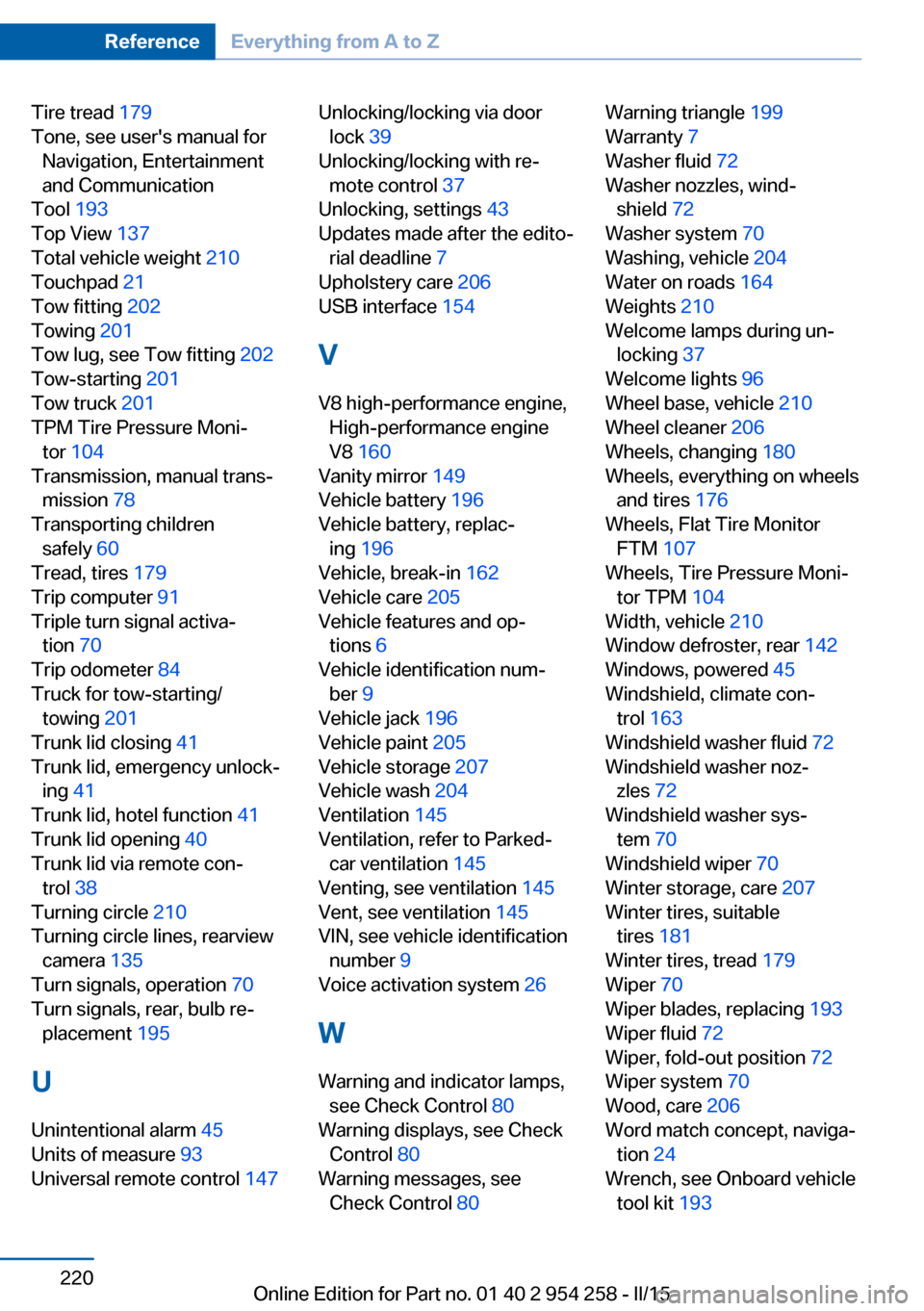
Tire tread 179
Tone, see user's manual for Navigation, Entertainment
and Communication
Tool 193
Top View 137
Total vehicle weight 210
Touchpad 21
Tow fitting 202
Towing 201
Tow lug, see Tow fitting 202
Tow-starting 201
Tow truck 201
TPM Tire Pressure Moni‐ tor 104
Transmission, manual trans‐ mission 78
Transporting children safely 60
Tread, tires 179
Trip computer 91
Triple turn signal activa‐ tion 70
Trip odometer 84
Truck for tow-starting/ towing 201
Trunk lid closing 41
Trunk lid, emergency unlock‐ ing 41
Trunk lid, hotel function 41
Trunk lid opening 40
Trunk lid via remote con‐ trol 38
Turning circle 210
Turning circle lines, rearview camera 135
Turn signals, operation 70
Turn signals, rear, bulb re‐ placement 195
U
Unintentional alarm 45
Units of measure 93
Universal remote control 147 Unlocking/locking via door
lock 39
Unlocking/locking with re‐ mote control 37
Unlocking, settings 43
Updates made after the edito‐ rial deadline 7
Upholstery care 206
USB interface 154
V
V8 high-performance engine, High-performance engine
V8 160
Vanity mirror 149
Vehicle battery 196
Vehicle battery, replac‐ ing 196
Vehicle, break-in 162
Vehicle care 205
Vehicle features and op‐ tions 6
Vehicle identification num‐ ber 9
Vehicle jack 196
Vehicle paint 205
Vehicle storage 207
Vehicle wash 204
Ventilation 145
Ventilation, refer to Parked- car ventilation 145
Venting, see ventilation 145
Vent, see ventilation 145
VIN, see vehicle identification number 9
Voice activation system 26
W Warning and indicator lamps, see Check Control 80
Warning displays, see Check Control 80
Warning messages, see Check Control 80 Warning triangle 199
Warranty 7
Washer fluid 72
Washer nozzles, wind‐ shield 72
Washer system 70
Washing, vehicle 204
Water on roads 164
Weights 210
Welcome lamps during un‐ locking 37
Welcome lights 96
Wheel base, vehicle 210
Wheel cleaner 206
Wheels, changing 180
Wheels, everything on wheels and tires 176
Wheels, Flat Tire Monitor FTM 107
Wheels, Tire Pressure Moni‐ tor TPM 104
Width, vehicle 210
Window defroster, rear 142
Windows, powered 45
Windshield, climate con‐ trol 163
Windshield washer fluid 72
Windshield washer noz‐ zles 72
Windshield washer sys‐ tem 70
Windshield wiper 70
Winter storage, care 207
Winter tires, suitable tires 181
Winter tires, tread 179
Wiper 70
Wiper blades, replacing 193
Wiper fluid 72
Wiper, fold-out position 72
Wiper system 70
Wood, care 206
Word match concept, naviga‐ tion 24
Wrench, see Onboard vehicle tool kit 193 Seite 220ReferenceEverything from A to Z220
Online Edition for Part no. 01 40 2 954 258 - II/15